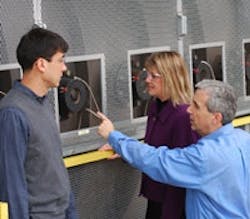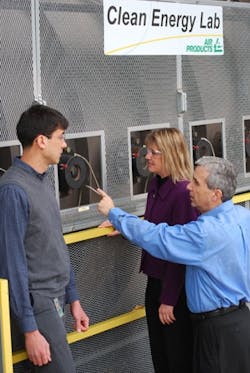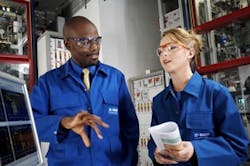Retirement Casts a Long Shadow
With a substantial portion of their engineers and operators nearing retirement age, many chemical companies face the risk of losing crucial know-how as experienced staff leave. Indeed, in a fairly recent CP online poll, nearly half of the respondents said that retirement of baby boomers would significantly affect their sites (www.chemicalprocessing.com/articles/2011/survey-baby-boomer-retirement/). Some companies are hoping to defuse this demographic time bomb through a variety of initiatives for capturing and transfering older workers' knowledge and experience.
For instance, Air Products, Allentown, Pa., is over four years into developing its procedures for knowledge retention and transfer.
Figure 1. About two-thirds of the education at Air Products' corporate university comes from informal learning techniques. Source: Air Products.
[Related: Operator Training Gains Ground]
While these trends have helped, the central challenge always has been how to physically capture and retain important knowledge.
"Engineers, in particular, think of knowledge transfer in terms of explicit knowledge — process flow diagrams, engineering standards and so forth. But 80% of the critical engineering knowledge is actually tacit knowledge. It is the insight as to why we did it that way, or the undocumented way we thought through the solution. We must transfer tacit knowledge using tacit methods," he says.
As a result, over two-thirds of the education in the company's corporate university is focused on informal learning techniques such as communities of practice, two-in-the-box (i.e., working side-by-side), after-action reviews or storytelling (Figure 1). After-action reviews, in particular, are proving very good tools for transfering tacit knowledge.
Grassi explains: "We have an established structure and procedure. We have created an online wiki workbook. The workbook contains tools, such as those mentioned above, and a process to accomplish knowledge transfer. This is set up as a wiki so that the 11 college knowledge managers within our corporate university can add to it as they learn how to do things better. Some tools are very obvious, for example there are after-action reviews to focus on the lessons learned. But the tool is structured to simplify this. Also it focuses on the tacit knowledge — the 80% of knowledge that emerges in discussions. The rest generally emerges as a small number of bullet points that simply have to be learned."
Air Products now is working toward two goals: the next step and the grand leap. The first essentially relates to refining existing procedures — using the process and tools for knowledge transfer throughout the enterprise, while improving the methods and documenting them in the wiki.
The grand leap involves moving to a culture of knowledge sharing and transfer within Air Products. "I see this following the progression of the safety culture in the chemical industry. Identifying the best ways to transfer knowledge, continual practice by using the methods, and documenting these into a framework that is easy to follow and can be used by everyone. So long-term we will have a knowledge transfer culture in the same way that we have a safety culture now," he concludes.
SHARING BEST PRACTICES
Dow AgroSciences, Indianapolis, Ind., which focuses on two business platforms: crop protection, and seeds, traits and oils, faces a significant potential know-how loss. "Forty to fifty percent of our experienced staff within these platforms will become eligible for retirement over the next 4–5 years — so a lot of knowledge could very soon walk straight out of the door," explains Jeannie Phillips, R&D senior project manager. Phillips also is involved in mature worker engagement (i.e., efforts to retain veterans and foster their sharing of expertise), knowledge transfer and other aspects of accelerated development for R&D personnel.
Dow AgroSciences has been growing over the last few years and has hired hundreds of new employees. "So it is important that they should benefit from the knowledge of the older workers, too," she adds.
In response to these twin challenges, the company is pursuing a number of knowledge transfer initiatives in its R&D, operations and commercial functions. To ensure sharing of best practices across the company, these efforts will draw on Dow's experience of creating and sustaining communities of practice (CoPs) in its wider business activities.
[Related: Training Moves With the Times]
The plan is to use a technology platform such as the internal social networking site to connect the community. "We are conducting a pilot in R&D right now to determine if this type of platform will be effective," says Phillips.
Figure 2. Opal 21 training units include practice-based questions and tasks related to an individual plant within an integrated complex. Source: BASF.
[Related: Leadership Focus Podcast: Improving Operator Performance]
Much of the development work for the SPA has come from COP research into modularizing emergency procedures. This pointed up the need to make updating and modifying existing procedures easier. It also found that about 80% of the material in procedures is duplication. "This means that the amount of information that really needs to be updated/current is only around 20% of the total volume of the procedures. For example, a unit that has 100 pages of procedures may really only have 20 pages of unique information. Put those 20 pages in a database that can be accessed by each procedure that needs the procedure step(s) and the update processing just became significantly easier," says Strobhar.
To highlight the importance of this, he cites the case of a COP member company that found variations that shouldn't exist in certain procedures. One, for example, required four steps to shut down a heater while another called for five. "Which one is accurate? From a legal standpoint you now have inconsistencies. If one step in a procedure has been changed, that step should be changed everywhere… there are huge corporate risk implications if this isn't done."
The SPA software also has the capability to learn to adapt over time so that fewer corrections need to be made.
The final version of the software will be available online to COP member companies by the end of the year, he hopes.
"Once we have that complete, we will move into our next steps in knowledge management, which will potentially use the storytelling technique. Gary Klein, author of 'Sources of Power' and an expert in decision-making, says the key to learning is from real-life lessons and stories. They are more important than retelling the simple physics behind why a certain decision was taken. I see this as a real potential area of use. Creating a protocol for capturing this event knowledge will be a key area," Strobhar concludes.



